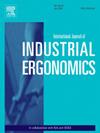Generalization of inverse kinematics frameworks based on deep learning to new motor tasks and markersets
IF 2.5
2区 工程技术
Q2 ENGINEERING, INDUSTRIAL
International Journal of Industrial Ergonomics
Pub Date : 2025-01-01
DOI:10.1016/j.ergon.2024.103670
引用次数: 0
Abstract
Several systems propose to monitor the activity of workers in industry, with markerless Human Pose Estimation (HPE) methods based on deep learning. However, these systems simply provide sparse 3D human body keypoints, including noise and missing information. Hence, these sparse and noisy keypoints cannot be directly used to assess the biomechanical constraints associated with professional activity. Indeed, computing these constraints would require more accurate and high frequency motion capture data to compute reliable joint angles, or using inverse kinematics frameworks (such as OpenSim). Deep-learning (DL) based approaches, such as Opencap, have been introduced to estimate additional anatomical markers’ positions, to overcome this limitation. However, such DL-based methods rely on training datasets and predefined keypoints and markersets, and their ability to generalize to other tasks or experimental conditions is still unclear. In this paper, we assess the ability of Opencap, pre-trained with bipedal locomotion dataset, to generalize (i.e. estimate reliable 3D positions of additional anatomical markers) to bi-manual manipulation and picking tasks, and new markersets. Fine tuning, commonly used in DL to generalize a model to new data, is a promising mean to deal with unseen motions and different experimental conditions, with a few set of new training data. We evaluated the performance of various fine tuning strategies, such as retraining the full model, only the last layers or adding an additional output layer. Our results showed an important decrease of the estimation error when using fine tuning on picking and manipulation tasks, with new markersets, compared to directly applying the pretrained Opencap model. This decrease of error is obtained with a limited training dataset of 140,000 poses, which is promising for future use in new measurement conditions and unseen motions, as frequently observed in industry.
Relevance to industry: Accurate Human Pose Estimation on-site is a key challenge to accurately assess musculoskeletal disorders with relevant and reliable biomechanical variables. However, RGB-based HPE used on-site generally provide sparse and noisy postural information, which is not compatible with standard biomechanical frameworks. This paper suggests and evaluates guidelines to overcome this limitation, and to make standard HPE methods be used in biomechanical framework. This open new avenues in estimating biomechanical variables that could improve the estimation of the musculoskeletal disorders risks directly in industrial context, as it is performed in laboratory conditions. This paper could be viewed as recommendations for companies which develop ergonomic assessment tools usable in industrial context.
基于深度学习的逆运动学框架推广到新的运动任务和标记集
有几个系统提出使用基于深度学习的无标记人体姿势估计(HPE)方法来监控工业工人的活动。然而,这些系统只是提供稀疏的3D人体关键点,包括噪声和缺失信息。因此,这些稀疏和嘈杂的关键点不能直接用于评估与专业活动相关的生物力学约束。事实上,计算这些约束将需要更精确和高频的运动捕捉数据来计算可靠的关节角度,或者使用逆运动学框架(如OpenSim)。基于深度学习(DL)的方法,如Opencap,已经被引入来估计额外的解剖标记的位置,以克服这一限制。然而,这种基于dl的方法依赖于训练数据集和预定义的关键点和标记集,其推广到其他任务或实验条件的能力尚不清楚。在本文中,我们评估了用双足运动数据集预训练的Opencap将(即估计额外解剖标记的可靠3D位置)推广到双手操作和拾取任务以及新标记集的能力。微调通常用于深度学习中将模型推广到新数据,它是一种很有前途的方法,可以处理未见过的运动和不同的实验条件,只需要几组新的训练数据。我们评估了各种微调策略的性能,例如重新训练整个模型,只训练最后一层或添加额外的输出层。我们的结果表明,与直接应用预训练的Opencap模型相比,在使用新标记集对挑选和操作任务进行微调时,估计误差显著降低。这种误差的减少是通过140,000个姿势的有限训练数据集获得的,这对于未来在新的测量条件和看不见的运动中使用是有希望的,正如在工业中经常观察到的那样。与工业相关:现场准确的人体姿势估计是使用相关可靠的生物力学变量准确评估肌肉骨骼疾病的关键挑战。然而,现场使用的基于rgb的HPE通常提供稀疏和嘈杂的姿势信息,这与标准的生物力学框架不兼容。本文提出并评价了克服这一局限性的指导方针,使标准的HPE方法在生物力学框架中得到应用。这为估计生物力学变量开辟了新的途径,可以直接在工业环境中改善对肌肉骨骼疾病风险的估计,因为它是在实验室条件下进行的。这篇论文可以被看作是对开发工业环境中可用的人体工程学评估工具的公司的建议。
本文章由计算机程序翻译,如有差异,请以英文原文为准。
求助全文
约1分钟内获得全文
求助全文
来源期刊
CiteScore
6.40
自引率
12.90%
发文量
110
审稿时长
56 days
期刊介绍:
The journal publishes original contributions that add to our understanding of the role of humans in today systems and the interactions thereof with various system components. The journal typically covers the following areas: industrial and occupational ergonomics, design of systems, tools and equipment, human performance measurement and modeling, human productivity, humans in technologically complex systems, and safety. The focus of the articles includes basic theoretical advances, applications, case studies, new methodologies and procedures; and empirical studies.

 求助内容:
求助内容: 应助结果提醒方式:
应助结果提醒方式:


